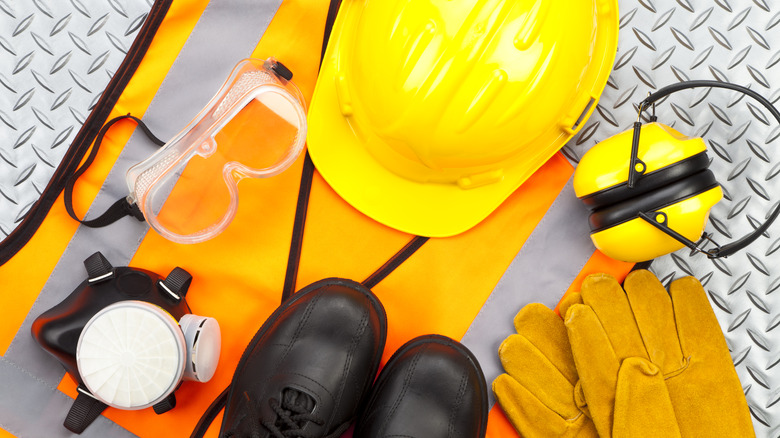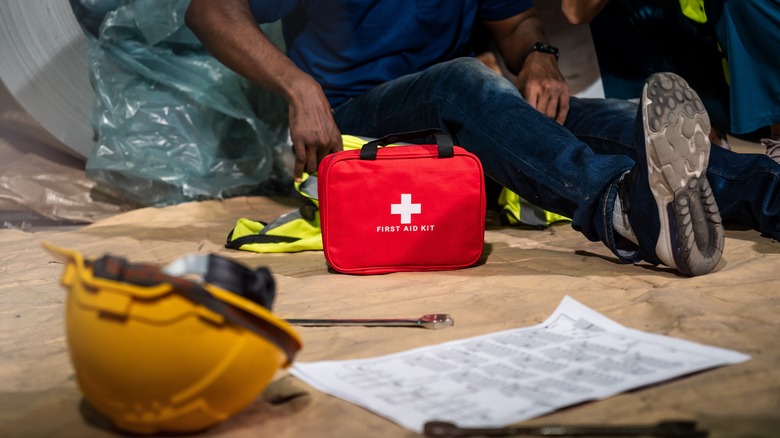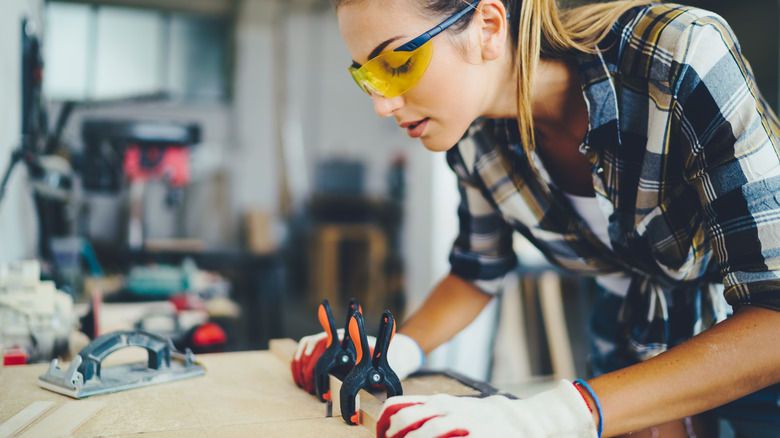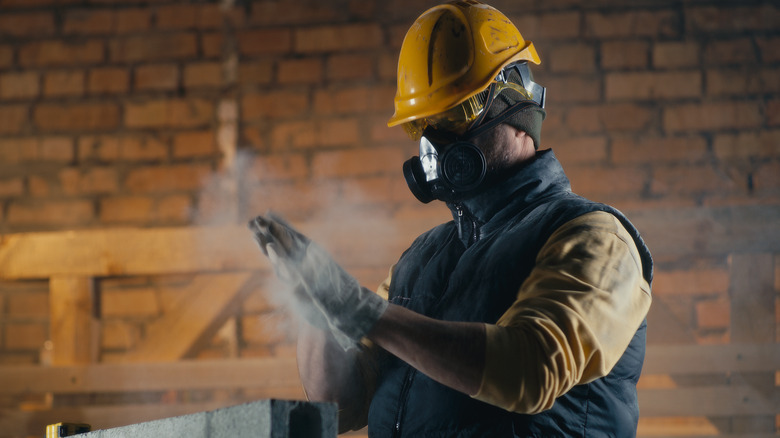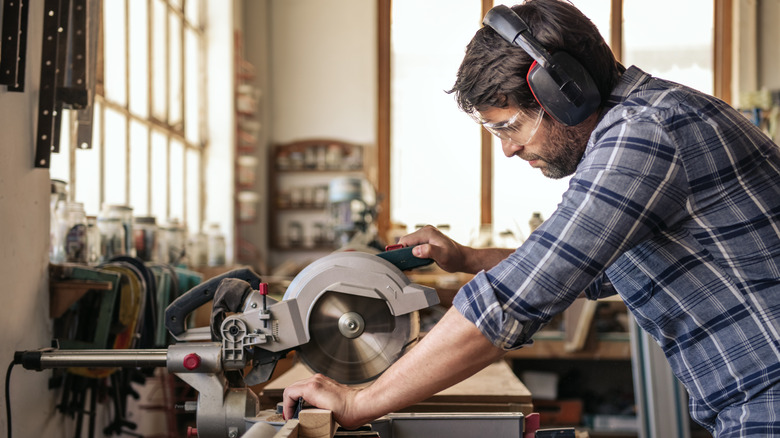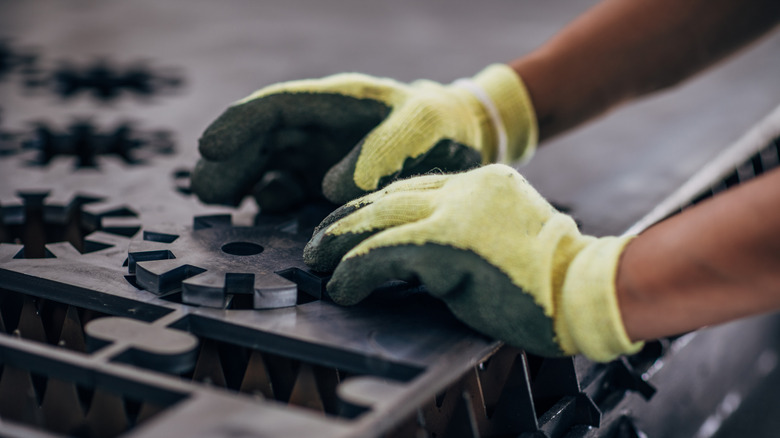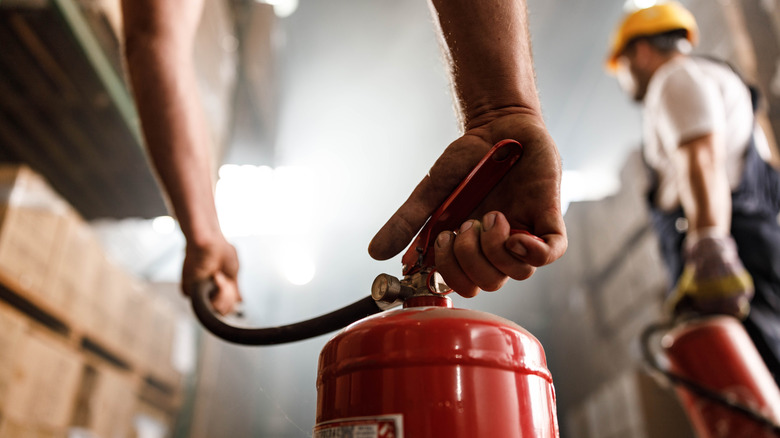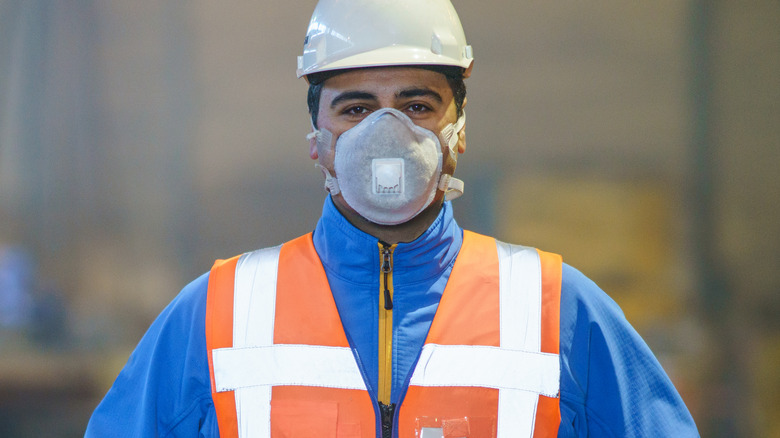Must-Have Safety Equipment You Should Buy Before Your Next At-Home DIY Project
We may receive a commission on purchases made from links.
Working on a DIY project in your home can be immensely satisfying for several reasons. Completing a project on your own can be personally fulfilling and build up your confidence, or, more pragmatically, it can be worth it for the money you'd save by not hiring an expensive professional to do it for you. However, when you do things yourself, you have to be extra careful, and that includes taking the proper safety precautions, especially if you're not a professional.
Larger companies have to comply with government safety regulations to protect their workers and others and can allocate part of their budgets for required safety equipment. When you're doing things yourself, however, you're responsible for ensuring you've got the right gear to protect yourself, your home, and anyone nearby. There is a wide range of safety equipment available, and you may not necessarily need all of it, but you likely need a lot of it if you want to prevent accidents and be properly prepared for when they occur.
Some equipment is geared toward protecting your body, some are geared toward protecting your property, and some are made to protect your tools and projects. Based on the hands-on testing and vetting by experts working for reputable publications, as well as some personal experience, here are some must-have safety items you should have on hand before starting your next at-home DIY project. More information on how these items were selected can be found at the end of this list.
First aid kit
The word "first" is right there in the name of first aid kits. They're meant to be easily accessible and provide you with items you'll need immediately after an accident. While they might not be a permanent solution for larger accidents, first aid can stabilize an injury long enough to get proper medical attention.
A good first aid kit will have all the basic supplies you'll need for a cut, burn, or similar injury. Ideally, everything will be kept in one place, so you won't have to think about where to find other items in an urgent situation. A first aid kit is one of the emergency items you should always keep in your car, but you should also keep one on hand wherever you're working on your DIY project, whether it's in your garage, basement, or tool shed.
I own two sets of the First Aid Only Essentials Kit, which has 298 individual pieces, including bandages, burn cream, painkillers, and a cold pack. Wirecutter named the product its "budget pick" after testing several first aid kits, noting that its components are cheaply made but still get the job done. GearLab also tested several sets and found the Johnson & Johnson All-Purpose First Aid Kit to have the "best value for home use," thanks to the high-quality supplies included (despite coming in a flimsy case).
Eye protection
Your eyes are some of the most important and vulnerable parts of your body, so you must protect them from debris, toxic chemicals, intense light, and more while working. If you're welding, you need to ensure your glasses can block out harmful UV and IR radiation and cut out the light from your welding torch. (Quality welding glasses can even be used for safely viewing a solar eclipse.)
To protect against debris while cutting or sawing, you'll want a good pair of safety goggles or glasses that are hard enough to withstand impacts and comfortable enough to properly fit. After vetting several items from different brands, Bob Vila named the DeWalt Concealer its "best bang for the buck" option for safety glasses; it's made with hard-coated, polycarbonate lenses that won't scratch or fog up and protect against UV rays. DeWalt Concealer goggles are available for just $12.24 from Amazon and Home Depot.
Another good choice is a pair of NoCry Safety Glasses, which Wirecutter called its "upgrade pick" for "the best safety glasses of 2024." After testing several options, Wirecutter praised NoCry's set for its highly adjustable fit for heads of all shapes and sizes. It also comes in several colors, though most options appear to be sold out.
Masks and respirators
Plenty of contractors, professionals, and DIY enthusiasts stock up on quality face masks and respirators, which protect your mouth and lungs against harmful particulates that can arise when cutting materials or when working with insulation, fiberglass, and harmful chemicals. Masks come in varying degrees of protection — P-Series particulate respirators (P95, P97, and P100), for example, are great for protecting your lungs from aerosols containing oil from wood stains, paints, and other finishes.
The easiest way to make sure you have proper protection is to buy a mask from brands that have been properly vetted. Even before COVID, I had a pack of 8210 N95 particulate respirators from 3M to use when air quality is significantly bad (from wildfires or other reasons). Wirecutter named this product one of its best "respirator masks for smoke and dust," as it can capture 95% of airborne particulates from home-renovation dust. However, these masks lack an exhalation valve, which you may prefer to use. I've also noticed that the latex straps tend to dry up and snap and break after more than a few uses.
If you prefer a permanent, reusable respirator that uses replaceable filters, the 3M 6502QL/49490 Rugged Comfort Quick Latch Half Facepiece is a great choice that's also been tested and recommended by Wirecutter. It can provide protection from harmful particulates at concentrations up to 10 times the permissible exposure limit standard set by OSHA. This mask is less flexible than disposable ones, and you need to make sure you get a size that fits snugly around your head to ensure it works as intended.
Hearing protection
If you're working with loud equipment like power saws or even lawnmowers, you should do your best to protect your ears, as extended exposure to loud sounds can damage your hearing. After field testing a number of different options, Bob Vila named the Decibel Defense Safety Earmuffs its best overall product for hearing protection. The over-the-ear muffs are rugged and durable enough for a work area and can reduce noise by 34 decibels, which is more than most of the competition. (OSHA recommends workers limit prolonged exposure to any sounds higher than 85 decibels). One drawback to these earmuffs is that you need to make sure you realign the foam padding so that it properly fits before using them for the first time, or they won't be as effective.
If you prefer using earplugs rather than larger over-the-ear muffs, a good option is a set of Minuendo High-Fidelity Acoustic Earplugs. In its list of tested products, CNET named Minuendo's set its "best overall earplugs to prevent hearing loss for 2024." While they're not as strong as Decibel Defense's muffs, they can still reduce sounds by up to 25 decibels (and they're adjustable, if you don't want to reduce noise by that much for some reason). They're pretty expensive, but if you've got the budget for them, you'll appreciate their modern, sleek design that looks more like a premium set of wireless headphones than an important piece of safety equipment for the jobsite.
Work gloves
Work gloves are another type of must-have safety equipment for DIY projects, as they can protect your hands from a number of hazards, including cuts, burns, chemicals, and even cold weather. Made from cotton, nylon, and polyurethane synthetic leather, a pair of Carhartt A518 work gloves ($19) would be a great addition to your DIY equipment. When tested by USA Today, the gloves proved to be resistant against knife cuts, while also protecting fingertips, knuckles, wrists, and palms, so it's no surprise that the publication named them its best work gloves of 2024. They come in five different sizes ranging from small to XXL, so there's a good chance you'll find a size that properly fits your hands.
Despite being strong and durable, Carhartt's gloves aren't suited for getting wet or guarding against freezing temperatures. If you're planning on working outdoors in the winter and need proper protection, you can go with a set of Milwaukee Performance Work Gloves ($30.97), which is one of the best Milwaukee products to keep you warm when working in the cold.
Not only will they keep your hands insulated, but Milwaukee's gloves will also protect against cuts and splinters. Even better, you won't lose much dexterity thanks to its thinner, flexible material. You can also expose your fingertips while using them for a more useful grip. However, Pro Tool Reviews, which tested the gloves and gave them a positive review, warned that they may potentially fit too loosely for your liking.
Fire extinguisher
In addition to wearing safety gear that will physically protect you from bodily harm, you'll also want to make sure your work area is equipped with safety equipment to protect your home. A fire extinguisher should be a mandatory item kept in your garage or wherever you work on DIY projects. Even if you're not directly working with fire, accidents can occur and it's smart to be prepared.
The First Alert FE2A10GR Home 2 Pro ($52) is a reliable fire extinguisher, which is why I keep two in accessible locations in my home for emergencies. USA Today called the product one of its best fire extinguishers of 2024, stating that it's ideal for small and medium fires. Since it's designed for fires caused by wood, paper, gas, liquids, and electrical issues, it's well-suited for flames that may accidentally erupt from your DIY project. It's reusable, which is convenient, but it's also on the heavier side if that's a concern.
Another good fire extinguisher to go with is the Amerex B402 ($67.99), which Wirecutter named one of its best fire extinguishers, praising its aluminum valve and recharging capabilities. It has a large capacity of fire-suppressing chemicals, which is great for drowning out flames before they have a chance to spread or reignite. However, this large output of dry chemicals means you might have to clear out of the room for a bit after using it, and it will leave a pretty sizable mess for you to clean up afterward.
How the recommended safety equipment on this list was selected
You never want to purchase a tool or other piece of equipment that turns out to be ineffective and a waste of your money, but it's especially important that any safety gear you buy works as intended. If you can't test a product yourself before purchasing, the next best thing is to rely on the expert opinions of those who've tested and vetted it for a reputable publication. All of the products recommended in this list of must-have safety equipment for at-home DIY projects have been tested and given positive reviews by publications that have plenty of experience evaluating tools and other hardware. These publications include GearLab, The New York Times Wirecutter, Bob Vila, Pro Tool Reviews, CNET, and USA Today. Additionally, I own some of the recommended products on this list, which I've personally used and can vouch for their effectiveness.
You can never have too much safety equipment, but to keep things concise, some items that are less likely to specifically be needed at home were left off this list. For example, bright yellow or orange safety vests are incredibly important for visibility on construction sites and in other professional settings, but less so if you're tinkering by yourself in your own garage. So, while this list of recommended safety equipment is useful for at-home DIY projects, don't consider it complete if you're planning on working in other situations as well.
